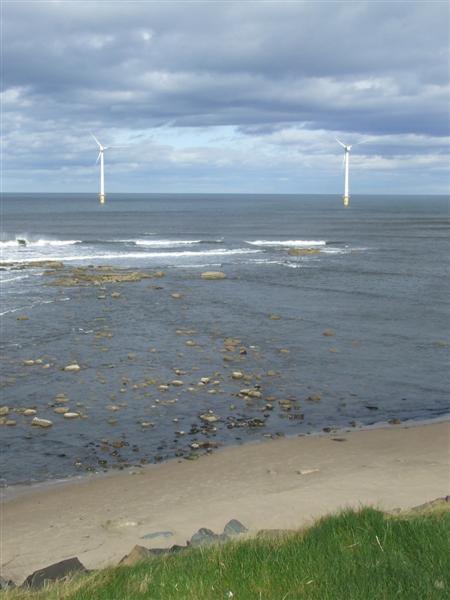Research sponsored by the Department of Energy (DOE) suggests that there's 54 gigawatts of wind power sitting untapped on our coasts. For comparison, Southern Company (SO 0.62%) is building a cutting edge coal-fired power plant with carbon-capture technology. The Kemper plant will produce roughly 580 megawatts of power. Do the math and you'll find that our offshore wind resources represent about 90 Kemper coal plants' worth of power -- so what are we waiting for?
Not as simple as it looks
For starters, building an offshore wind farm isn't exactly a simple process. Not only do you need to construct the farm, but you also have to connect it to the grid. Wind generators without wires are just giant pinwheels in the sea. And don't underestimate the technological achievement of installing a windmill in the ocean, let alone the fact that said windmills can survive in such a hostile environment. In other words, putting wind power up in the ocean is hard.

Source: Michael Batey, via Wikimedia Commons
However, it's being done right now in other countries. For example, the United Kingdom gets around 3% of its power, or 3.7 gigawatts (about seven Kemper plants), from offshore wind right now. The goal is to get to 11 gigawatts by 2020. That would keep the U.K. in the lead position for offshore wind. Right now the country is home to half of the world's offshore wind power, but growth in other nations should lead that to fall to about a third in 2020 despite the U.K.'s planned investments in the space.
But the United Kingdom shows some of the issues facing offshore wind. For example, industry consultant Swati Singh of GlobalData recently told Fierce Energy, "Overall project costs have risen as a result of increasing water depths, distance from the shore and average turbine size." In other words, the low-hanging fruit has been picked.
Push back
That said, no offshore wind fruit has been plucked back in the United States. But that's not because companies don't want to try. For example, the DOE research included experts from giant utility Duke Energy (DUK 0.64%) and international engineering firm ABB (ABBN.Y 0.68%). Duke would love to get some reliable green power to help it meet green mandates and ABB would be just as pleased to help put it up.
But so far, customers don't seem to be so willing. Take, for example, the Cape Wind project in Nantucket Sound in Massachusetts. It will consist of 130 Siemens (SIEGY 0.85%) offshore wind turbines and produce around 460 megawatts of power (a little under one Kemper). This project was first conceived in 2001 and is only now starting to break ground, or water, as the case may be. That's over a decade of preliminary work largely spent fighting opposition groups.
Although it looks increasingly likely that this project will get built, it will still be just the first offshore wind array in the United States. But the future could be brighter once one project gets done since there are over a dozen other projects on the drawing board. In total the planned projects could provide as much as 4.9 gigawatts of power.
However, John Daniel of ABB, didn't sound so optimistic on reaching the 54 gigawatt milestone in the DOE report he helped author when he told USA Today, "We could eventually get there." He cited high installation costs, noting that relatively low natural gas prices are a tough competitor. Still, adding over a decade of fighting to the process of installing the country's first offshore wind farm has to be factored in, too. Having to deal with "not in my backyard" (NIMBY) complaints is hard to overcome, and is also perhaps a surprising revelation since the goal is to replace dirty, carbon spewing power plants with clean wind power. And Cape Wind isn't alone in getting such NIMBY pushback.

Source: Glyn Baker, via Wikimedia Commons
Ready to blow?
U.S. offshore wind could be a huge market for utilities, engineering firms, and construction companies. The big test will be Cape Wind. If that project gets done, the market might open up. However, costs, including both construction and fighting opposition groups, will be a factor that could kill any, and all, of the currently proposed projects. Offshore wind, then, isn't the slam dunk the DOE's 54 gigawatt estimate suggests. And while it's a trend worth watching, don't expect an offshore boom to start anytime soon.




